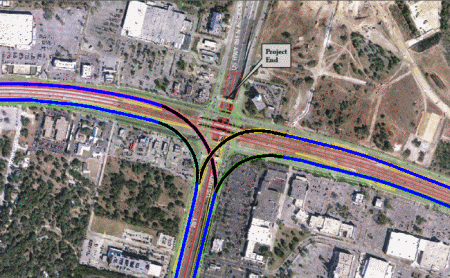Construction and closures Roads Toll roads: Alamo Regional Mobility Authority interchange Loop 1604 stimulus funds Terri Hall US 281
by Brian
3 comments
Terri’s at it again (part 1 of 2)
This past Monday, the Alamo Regional Mobility Authority (ARMA) held a public meeting to show their plans for the US 281/Loop 1604 interchange. The interchange is being funded primarily with federal economic stimulus funds and therefore will be built toll-free, but that’s not enough for local outspoken toll-opponent Terri Hall. She had a lot to say about the project on her MySA.com blog yesterday. I submitted a response to it last night, but as she has to approve it, it hasn’t been posted yet. (But I’m not really surprised.) So I’m going to respond to her here on my turf. Because her comments went all over the map, I’m going to break this response up into two posts: one about the costs of the interchange (today), and one about the environmental clearance it is getting (tomorrow).
So Ms. Hall starts-off her blog by saying that the 410/281 interchange, which went to bid in early 2005, cost $155 million for all eight ramps, while the proposed 281/1604 interchange, which would only build four ramps, will cost $140 million. She asserts that because only half the connectors will be built and because construction costs have been sagging this year that the price is way too high and must represent “padding” by including several ancillary improvements.
Only one of her assertions is actually true– yes, construction costs have dropped-off dramatically this year, down to about the level they were in late 2005. But they’re still about 22% higher than they were when the 410/281 interchange was funded, so that alone accounts for a good chunk of the difference.
More than half being built
Although she never says it outright, she does imply that since only half the connectors in the new interchange will be built that the costs should be roughly half those of the 410 interchange. However, what she doesn’t grasp is that actually about 75% of the new interchange is being built. Yes, only four connectors out of eight are to be built, but six out of the eight connector “common structures” will be built. Those are the upramps from the freeway and the elevated road that leads to the ramp split, and the elevated road from where the ramps come back together on the other side and the downramp to the other highway. I have marked these sections in blue on the diagram below.

The ramps from the north will tie into what will then be the four existing common structures to the left and right on 1604. Therefore, only two new common structures will need to be built to serve those new ramps, those being along 281 north of 1604. Because the length of those structures is considerably longer than the actual turning ramps, about 75% of the required elevated structures (measured by linear footage) for the full interchange will be completed in this project. In addition, much of the drainage infrastructure to support the full interchange will also be built in this project. The net result is that well more than half of a full interchange is being built, so Ms. Hall can’t try to make an apples-to-apples comparison in that fashion.
So, let’s look at the numbers:
75% of the $155 million for the 410/281 interchange is about $116 million. Take that and multiply it by the 22% construction inflation rate since early 2005 and you get about $142 million. ARMA’s projected cost for this project: $140 million. Sorry Terri, ARMA’s numbers work.
Ancillary improvements to blame
That aside, Ms. Hall wants to assert that several ancillary improvements that will be made to 281 and 1604 in conjunction with this project are what’s driving the costs up. Again, although she says she wants to compare apples to apples, she’s not. The 410/281 interchange project also included several supplementary improvements on 281 from Nakoma all the way to Hildebrand, including widening 281, redoing the exits to Jones-Maltsberger both north and south of 410, and adding TransGuide to that stretch of 281, not to mention repaving all of it. That project also included the widening and improvements to Loop 410 from Jones-Maltsberger to Broadway. So that project included lots of “padding” as well, in her lingo.
She claims that similar enhancements to be included in the 1604 interchange project have NOTHING to do with the interchange, but again, she’s just dead wrong. Those improvements, like those made to 281 in conjunction with the 410 interchange, are designed to mitigate the effects that the new connectors will have on traffic upstream and downstream from the interchange. We all know from experience that when a major bottleneck is removed from a highway, all the traffic that it frees-up can cause other issues further downstream. Most of the ramp revisions and auxiliary lanes planned as part of this project are intended to address those issues. In a nutshell, this is good planning. Additionally, a number of safety improvements (such as illumination and sidewalks) will be included, and repaving both 281 and 1604 is necessary because all the improvements will change the pavement in several locations. Now I will agree with Ms. Hall that the two proposed pedestrian bridges on each side of 1604 at 281 might cross the line as being a tad excessive, but everything else in the plans makes sense and is not superfluous.
Finally, she claims that the $84 million for those enhancements should be spent to build the roughly $60 million northern ramps. However, those ramps cannot be built right now because they are included in the scope for the 281 environmental impact statement (EIS), which Ms. Hall herself sued to get and which won’t be completed until sometime around 2012.
We’ll pick up there tomorrow.